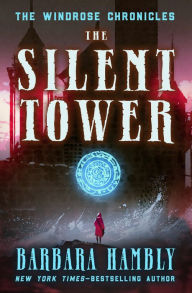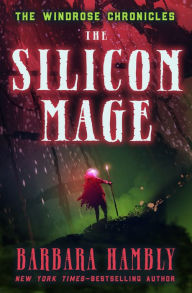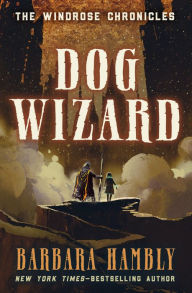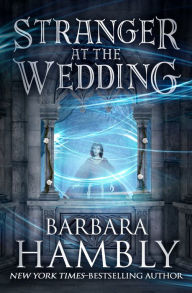Throwback Thursday: The Windrose Chronicles Are Timeless Fantasy Novels That Could Only Have Been Written in the ’80s
The Silent Tower
The Silent Tower
In Stock Online
eBook $9.99
Published in 1986, The Silent Tower began a new fantasy series by legendary author Barbara Hambly: The Windrose Chronicles. The year is significant, because while these classic books have all the usual traits found in Hambly’s SF/F (she’s written extensive in mystery and historical fiction as well), including great characters, attention to detail, and a fondness for portal stories, they also rely extensively on the one thing that an author can’t control or predict: technology. In short, while books of The Windrose Chronicles are great fantasy reads, they are also so dated, younger readers might have trouble even understanding some of the references.
Back in the day
1986 was a different time. The internet as we know it didn’t exist. Smartphones didn’t exist. Computers were, by our standards, supremely underpowered and largely text-based (Windows 1.0 had just been released). Digital storage meant 5.25-inch floppy disks, which held, at most, 1.2 megabytes of information. Although it came out in 1983, the film War Games probably gives you the best idea of what the world of personal computing was like as Hambly was writing this series.
Published in 1986, The Silent Tower began a new fantasy series by legendary author Barbara Hambly: The Windrose Chronicles. The year is significant, because while these classic books have all the usual traits found in Hambly’s SF/F (she’s written extensive in mystery and historical fiction as well), including great characters, attention to detail, and a fondness for portal stories, they also rely extensively on the one thing that an author can’t control or predict: technology. In short, while books of The Windrose Chronicles are great fantasy reads, they are also so dated, younger readers might have trouble even understanding some of the references.
Back in the day
1986 was a different time. The internet as we know it didn’t exist. Smartphones didn’t exist. Computers were, by our standards, supremely underpowered and largely text-based (Windows 1.0 had just been released). Digital storage meant 5.25-inch floppy disks, which held, at most, 1.2 megabytes of information. Although it came out in 1983, the film War Games probably gives you the best idea of what the world of personal computing was like as Hambly was writing this series.
The Silicon Mage
The Silicon Mage
In Stock Online
eBook $9.99
The Windrose Chronicles tells the story of a computer programmer named Joanna, brought through “The Void” into a world known as Ferryth. In Ferryth, magic works, but is suppressed by a monolithic church that regards wizards and spells as evil. Joanna teams up with a warrior named Caris, seeking answers to what’s happened to her, as Caris investigates a murderer who appears to move between worlds magically. The pair soon uncovers the true plot: Suraklin, the Dark Mage, is basically trying to upload his mind into a computer, using energy from both our world and his own. The plot involves CP/M (more on that in a bit), magic, and a pocket universe, and if you can look past the dated tech references, it’s kind of crazy genius.
Tech-infused
Hambly doesn’t just use a few techno terms to establish the theme of technology’s power in contrast with magic, she actually infuses it into her characters and world-building. Instead of a typically medieval fantasy world, Ferryth is a civilization on the cusp of the Industrial Revolution, and the conflict between magic and the technology causes a great deal of tension; technology is shown to make magic even more powerful, which is a novel idea for fantasy. Joanna is a programmer through and through, seeing problems as a series of subroutines and working through logical solutions. She’s also a kickass character, never a damsel in distress—which was especially refreshing in 1986.
The Windrose Chronicles tells the story of a computer programmer named Joanna, brought through “The Void” into a world known as Ferryth. In Ferryth, magic works, but is suppressed by a monolithic church that regards wizards and spells as evil. Joanna teams up with a warrior named Caris, seeking answers to what’s happened to her, as Caris investigates a murderer who appears to move between worlds magically. The pair soon uncovers the true plot: Suraklin, the Dark Mage, is basically trying to upload his mind into a computer, using energy from both our world and his own. The plot involves CP/M (more on that in a bit), magic, and a pocket universe, and if you can look past the dated tech references, it’s kind of crazy genius.
Tech-infused
Hambly doesn’t just use a few techno terms to establish the theme of technology’s power in contrast with magic, she actually infuses it into her characters and world-building. Instead of a typically medieval fantasy world, Ferryth is a civilization on the cusp of the Industrial Revolution, and the conflict between magic and the technology causes a great deal of tension; technology is shown to make magic even more powerful, which is a novel idea for fantasy. Joanna is a programmer through and through, seeing problems as a series of subroutines and working through logical solutions. She’s also a kickass character, never a damsel in distress—which was especially refreshing in 1986.
Dog Wizard
Dog Wizard
In Stock Online
eBook $11.99
But while this throughline of technology in a fantasy setting works wonderfully, the dated nature of the tech can be distracting. Consider, for example, my earlier reference to CP/M—go ahead and Google it. If you don’t know what she’s referencing, the key role this 30-year-old tech plays in the plot can cause unintended confusion. Perhaps it is a lesson for authors: when working technology into your stories, make sure to consider how fast things change.
The Fourth Doctor … er, wizard
Hambly’s final bit of genius, one that makes overlooking any dated references more than worthwhile, is the character of Antryg Windrose, a “mad wizard” who’s not so much crazy as so out of step with his own world and people, he is perceived as a nutter. He’s also burdened with having to maintain an objective view of reality that is often far, far removed from what others insist is real.
But while this throughline of technology in a fantasy setting works wonderfully, the dated nature of the tech can be distracting. Consider, for example, my earlier reference to CP/M—go ahead and Google it. If you don’t know what she’s referencing, the key role this 30-year-old tech plays in the plot can cause unintended confusion. Perhaps it is a lesson for authors: when working technology into your stories, make sure to consider how fast things change.
The Fourth Doctor … er, wizard
Hambly’s final bit of genius, one that makes overlooking any dated references more than worthwhile, is the character of Antryg Windrose, a “mad wizard” who’s not so much crazy as so out of step with his own world and people, he is perceived as a nutter. He’s also burdened with having to maintain an objective view of reality that is often far, far removed from what others insist is real.
Stranger at the Wedding
Stranger at the Wedding
In Stock Online
eBook $9.99
Hambly admits she based Windrose explicitly on Tom Baker’s interpretation of Doctor Who, and once you know, it’s obvious: Windrose is abrupt, smarter than everyone else, and easy to distrust or condemn because he has knowledge that only the villain should have—but it’s simply because he’s so much smarter than everyone. The evolving relationship between Windrose and Joanna is one of the best things about the books.
If you can look past ancient operating systems, long-surpassed protocols, and the presence of floppy disks as a vital aspect of technology, The Windrose Chronicles (continued in The Silicon Mage, and Dog Wizard—the standalone Stranger at the Wedding is set in Ferryth but doesn’t have an explicit connection) is a brisk adventure in a well-drawn fantasy world, starring some of the most developed and downright lovable characters you’ll find in portal fantasy.
Hambly admits she based Windrose explicitly on Tom Baker’s interpretation of Doctor Who, and once you know, it’s obvious: Windrose is abrupt, smarter than everyone else, and easy to distrust or condemn because he has knowledge that only the villain should have—but it’s simply because he’s so much smarter than everyone. The evolving relationship between Windrose and Joanna is one of the best things about the books.
If you can look past ancient operating systems, long-surpassed protocols, and the presence of floppy disks as a vital aspect of technology, The Windrose Chronicles (continued in The Silicon Mage, and Dog Wizard—the standalone Stranger at the Wedding is set in Ferryth but doesn’t have an explicit connection) is a brisk adventure in a well-drawn fantasy world, starring some of the most developed and downright lovable characters you’ll find in portal fantasy.



